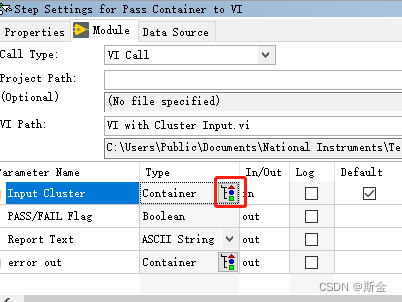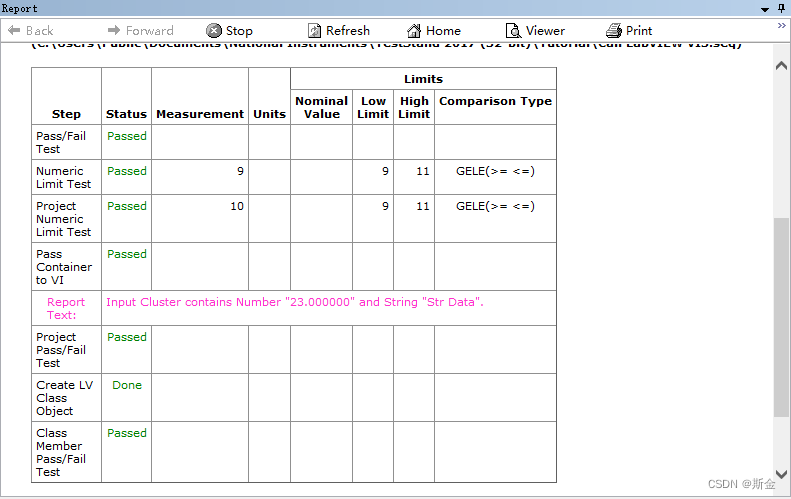从LabVIEW创建TestStand数据类型的簇
TestStand提供数字、字符串、布尔值和对象引用内置数据类型。
TestStand还提供了几种标准的命名数据类型,包括路径、错误、LabVIEW模拟波形等。可以通过创建容器数据类型来保存任何其他数据类型的数量。TestStand容器数据类型类似于LabVIEW的簇。
创建一个与LabVIEW的簇匹配的TestStand数据类型。
-
选择File-Save < filename> As,并将序列文件保存为
Call LabVIEW VI 3.seq。< TestStand Public>\Tutorial目录中。 -
在LV Project Numeric Limit Test后面的主步骤组中插入Pass/Fail Test步骤并将新步骤命名为Pass Container to VI。
3.在module选项卡上,点击browse VI按钮,导航到< TestStand Public>\Tutorial\vi with Cluster Input.vi,单击打开。
-
单击Type按钮,启动Create/Update Custom Data Type from Cluster对话框。

TestStand将簇元素映射到名为Input_Cluster的容器中的子属性,这是一个新的TestStand自定义数据类型。可以根据需要重命名数据类型和子属性,并指定TestStand存储新数据类型的位置。 -
在Create /Update Custom Data Type from Cluster对话框中,将类型名称更改为InputData并单击Create按钮接受自动分配的值和在当前序列文件中创建数据类型。
-
在module 选项卡上,从default列中取消Input Cluster的选中,单击Value列中的Expression Browser Dialog box按钮

a.在Variables/Properities选项卡上,右击Locals-Insert Types-InputData,新建的数据命名为ContainerData。

b.右击ContainerData的Number-Properties打开Number Properties对话框。
c.在value中输入23,单击OK。
d.右键单击ContainerData的String-Properties
e.在vlaue中输入str Data,单击OK。
f.Expression中输入Locals.ContainerData,单击OK。Input Cluster参数的Value列现在包含Locals.ContainerData。 -
在VI Parameter Table中输入值。
| 参数名称 | 值 |
|---|---|
| PASS/FAIL Flag | Step.Result.PassFail |
| Report Text | Step.Result.ReportText |
当TestStand调用VI时,它将ContainerData局部变量中的值传递给VI上的Input Cluster控件,并将Input Cluster参数的Number和String元素返回给步骤的ReportText属性。
-
保存更改并Execute-Single Pass。当执行完成时,报告显示带有Cluster Input VI的VI返回的文本。

-
关闭序列编辑器中的所有窗口。

























 401
401











 被折叠的 条评论
为什么被折叠?
被折叠的 条评论
为什么被折叠?










